国际经济与贸易专业主干课程翻译稿
- 格式:doc
- 大小:49.50 KB
- 文档页数:6
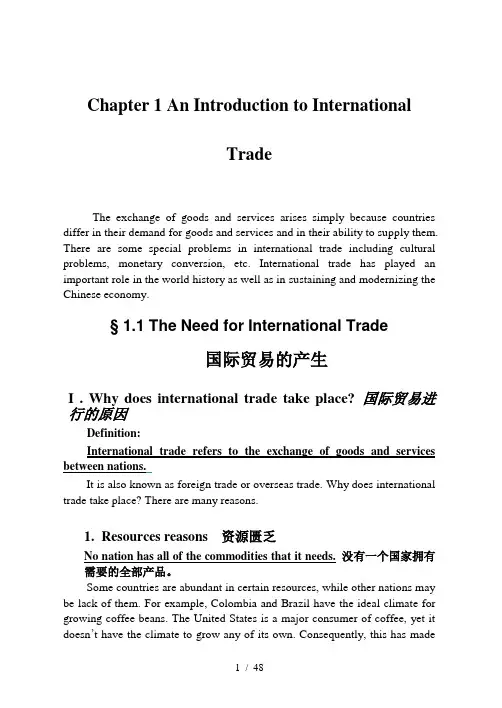
Chapter 1 An Introduction to InternationalTradeThe exchange of goods and services arises simply because countries differ in their demand for goods and services and in their ability to supply them. There are some special problems in international trade including cultural problems, monetary conversion, etc. International trade has played an important role in the world history as well as in sustaining and modernizing the Chinese economy.§ 1.1 The Need for International Trade国际贸易的产生I . Why does international trade take place? 国际贸易进行的原因Definition:International trade refers to the exchange of goods and services between nations.It is also known as foreign trade or overseas trade. Why does international trade take place? There are many reasons.1.Resources reasons 资源匮乏No nation has all of the commodities that it needs. 没有一个国家拥有需要的全部产品。
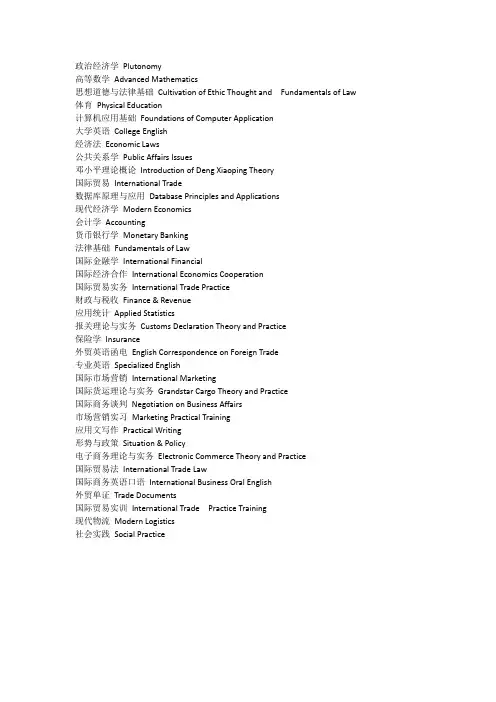
政治经济学Plutonomy高等数学Advanced Mathematics思想道德与法律基础Cultivation of Ethic Thought and Fundamentals of Law 体育Physical Education计算机应用基础Foundations of Computer Application大学英语College English经济法Economic Laws公共关系学Public Affairs Issues邓小平理论概论Introduction of Deng Xiaoping Theory国际贸易International Trade数据库原理与应用Database Principles and Applications现代经济学Modern Economics会计学Accounting货币银行学Monetary Banking法律基础Fundamentals of Law国际金融学International Financial国际经济合作International Economics Cooperation国际贸易实务International Trade Practice财政与税收Finance & Revenue应用统计Applied Statistics报关理论与实务Customs Declaration Theory and Practice保险学Insurance外贸英语函电English Correspondence on Foreign Trade专业英语Specialized English国际市场营销International Marketing国际货运理论与实务Grandstar Cargo Theory and Practice国际商务谈判Negotiation on Business Affairs市场营销实习Marketing Practical Training应用文写作Practical Writing形势与政策Situation & Policy电子商务理论与实务Electronic Commerce Theory and Practice国际贸易法International Trade Law国际商务英语口语International Business Oral English外贸单证Trade Documents国际贸易实训International Trade Practice Training现代物流Modern Logistics社会实践Social Practice。
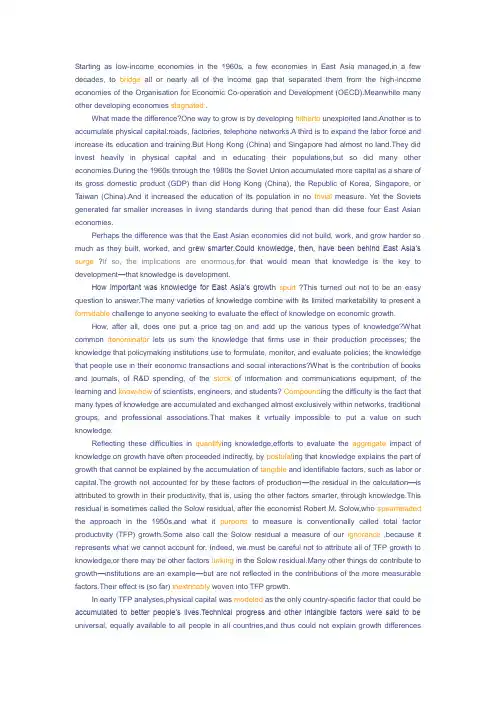
Starting as low-income economies in the 1960s, a few economies in East Asia managed,in a few decades, to bridge all or nearly all of the income gap that separated them from the high-income economies of the Organisation for Economic Co-operation and Development (OECD).Meanwhile many other developing economies stagnated .What made the difference?One way to grow is by developing hitherto unexploited land.Another is to accumulate physical capital:roads, factories, telephone networks.A third is to expand the labor force and increase its education and training.But Hong Kong (China) and Singapore had almost no land.They did invest heavily in physical capital and in educating their populations,but so did many other economies.During the 1960s through the 1980s the Soviet Union accumulated more capital as a share of its gross domestic product (GDP) than did Hong Kong (China), the Republic of Korea, Singapore, or Taiwan (China).And it increased the education of its population in no trivial measure. Yet the Soviets generated far smaller increases in living standards during that period than did these four East Asian economies.Perhaps the difference was that the East Asian economies did not build, work, and grow harder so much as they built, worked, and gr ew smarter.Could knowledge, then, have been behind East Asia’s surge ?If so, the implications are enormous,for that would mean that knowledge is the key to development—that knowledge is development.How important was knowledge for East Asia’s growt h spurt ?This turned out not to be an easy question to answer.The many varieties of knowledge combine with its limited marketability to present a formidable challenge to anyone seeking to evaluate the effect of knowledge on economic growth.How, after all, does one put a price tag on and add up the various types of knowledge?What common denominator lets us sum the knowledge that firms use in their production processes; the knowledge that policymaking institutions use to formulate, monitor, and evaluate policies; the knowledge that people use in their economic transactions and social interactions?What is the contribution of books and journals, of R&D spending, of the stock of information and communications equipment, of the learning and know-how of scientists, engineers, and students? Compound ing the difficulty is the fact that many types of knowledge are accumulated and exchanged almost exclusively within networks, traditional groups, and professional associations.That makes it virtually impossible to put a value on such knowledge.Reflecting these difficulties in quantify ing knowledge,efforts to evaluate the aggregate impact of knowledge on growth have often proceeded indirectly, by postulat ing that knowledge explains the part of growth that cannot be explained by the accumulation of tangible and identifiable factors, such as labor or capital.The growth not accounted for by these factors of production—the residual in the calculation—is attributed to growth in their productivity, that is, using the other factors smarter, through knowledge.This residual is sometimes called the Solow residual, after the economist Robert M. Solow,who spearheaded the approach in the 1950s,and what it purports to measure is conventionally called total factor productivity (TFP) growth.Some also call the Solow residual a measure of our ignorance ,because it represents what we cannot account for. Indeed, we must be careful not to attribute all of TFP growth to knowledge,or there may be other factors lurking in the Solow residual.Many other things do contribute to growth—institutions are an example—but are not reflected in the contributions of the more measurable factors.Their effect is (so far) inextricably woven into TFP growth.In early TFP analyses,physical capital was modeled as the only country-specific factor that could be accumulated to better people’s lives.Technical progress and other intangible factors were said to be universal, equally available to all people in all countries,and thus could not explain growth differencesbetween countries.Their contributions to growth were lumped with the TFP growth numbers.Although this assumption was convenient, it quickly became obvious that physical capital was not the only factor whose accumulation drove economic growth. A study that analyzed variations in growth rates across a large number of countries showed that the accumulation of physical capital explained less than 30 percent of those variations.The rest—70 percent or more—was attributed directly or indirectly to the intangible factors that make up TFP growth (Table 1.1).Later attempts introduced human capital to better explain the causes of economic growth.A higher level of education in the population means that more people can learn to use better technology. Education was surely a key ingredient in the success of four of the fastest-growing East Asian economies: Hong Kong (China), the Republic of Korea, Singapore, and Taiwan (China). Before their transformation from developing into industrializing economies, their school enrollment rates had been much higher than those of other developing countries (Table 1.2).They had also emphasized advanced scientific and technical studies—as measured by their higher ratios of students in technical fields than in even some industrial countries—thus enhancing their capacity to import sophisticated technologies.Moreover, the importance of education for economic growth had long been recognized and established empirically .One study had found that growth in years of schooling explained about 25 percent of the increase in GDP per capita in the United States between 1929 and 1982.Adding education reduced the part of growth that could not be explained,thus shrinking the haystack in which TFP growth (and knowledge) remained hidden.Some analysts even concluded, perhaps too quickly,that physical and human capital, properly accounted for, explained all or virtually all of the East Asian economies’ rapid growth,leaving knowledge as a separate factor out of the picture.One re ason these analysts came up with low values for TFP growth is that they incorporated improvements in labor and equipment into their measurement of factor accumulation.So even their evidence of low TFP growth in East Asia does not refute the importance of closing knowledge gaps.Indeed, it shows that the fast-growing East Asian economies had a successful strategy to close knowledge gaps:by investing in the knowledge embodi ed in physical capital, and by investing in people and institutions to enhance the capability to absorb and use knowledge.Looking beyond East Asia,other growth accounting studies have examined larger samples of countries.Even when human capital is accounted for,the unexplained part of growth remains high.One such study, of 98 countries with an unweighted average growth rate of output per worker of 2.24 percent,found that 34 percent (0.76 percentage point) of that growth came from physical capital accumulation,20 percent (0.45 percentage point) from human capital accumulation,and as much as 46 percent (just over 1 percentage point) from TFP growth.Even more remains to be explained in variations in growth rates across countries. The same study found the combined role of human and physical capital to be as low as 9 percent, leaving the TFP residual at a staggering 91 percent.To take another example:Korea and Ghana had similarly low incomes per capita in the 1950s,but by 1991 Korea’s income per capita was more than seven times Ghana’s.Much of that gap remains unexplained even when human capital is taken into account .All these results are subject to measurement problems.For example, the measured stock of human capital may overstate the actual quantity used in producing goods and services.High rates of school enrollment or attainment (years completed) may not translate into higher rates of economic growthif the quality of education is poor, or if educated people are not employed at their potential because of distortion s in the labor market.Moreover, it is now evident that education without openness to innovation and knowledge will notlead to economic development.The people of the former Soviet Union, like the people of the OECD countries and East Asia, were highly educated, with nearly 100 percent literacy .And for an educated population it is possible,through foreign direct investment and other means,to acquire and use information about the latest production and management innovations in other countries.But the Soviet Union placed severe restrictions on foreign investment, foreign collaboration, and innovation.Its work force did not adapt and change as new information became available elsewhere in the world, and consequently its economy suffered a decline.(excerpted from World Development Report 1998/1999)一些东亚国家在20世纪60年代还是低收入国家,但是在短短的几十年之间,他们成功地弥补了其与经济合作与发展组织(OECD)中高收入国家之间的差距;与此同时,也有许多发展中国家的经济停滞不前。
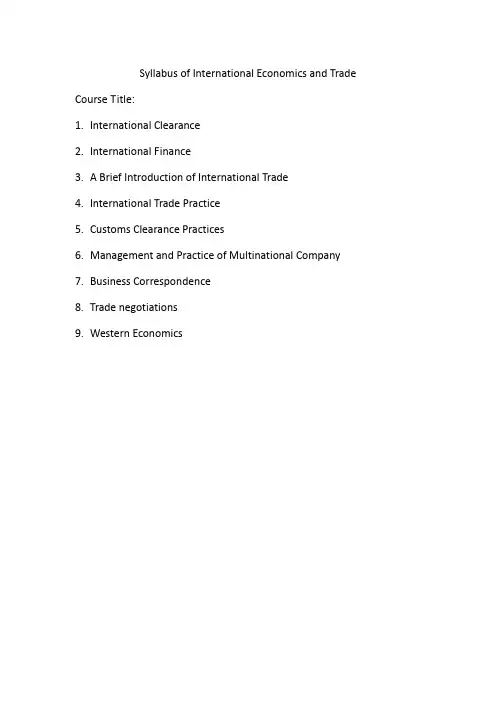
Syllabus of International Economics and Trade Course Title:1.International Clearance2.International Finance3.A Brief Introduction of International Trade4.International Trade Practice5.Customs Clearance Practices6.Management and Practice of Multinational Company7.Business Correspondence8.Trade negotiations9.Western EconomicsSyllabus of International FinanceFor: International Economics and Trade Total Class Hours: 54 Aims:This course introduces students to International Finance and equips them with basic concepts, and methods to study and analyze international economic issues and problems. It will lay a hard foundation for on Finance study and work in the future.Prerequisites:1.To understand properties, tasks and its researching targets; its system,structure overall2.To grasp basic concepts and theories, basic principles and methods,and development of international finance3.To learn to apply theories and principles to practice and analyzefinancial problems and specific cases with relevant theories.Teaching Mode:Lectures and case studyCourse Contents:Chapter one Foreign Currency and Exchange Rate1.1Definition and categories of currency1.2Definition, exchange quotation and categories of currency Rate1.3Currency basis and main factors affecting it1.4Function of currency changes to economyKey points and Difficulties:Exchange Quotation; main factors and functions of currency and currency changeChapter Two Currency System and Exchange Control2.1 Categories of currency system2.2 Fixed exchange rate and floating exchange rate2.3 History and purpose of exchange control2.4 Measures of exchange control2.5 Functions of exchange control2.6 Evolution and contents of foreign currency management in China2.7 RMB exchange rate system and its theoretical parityKey points and difficulties:Fixed exchange rate system and floating exchange rate system; pegging exchange rate, exchange control, complex exchange rate system, evasion, and arbitrage and Currency convertibilityChapter Three Foreign Exchange Market and Foreign Exchange Transactions3.1 What is foreign exchange market3.2 Major international markets and their transaction systems3.3 Transaction means3.3.1 Spot transactions and forward transactions3.3.2 Arbitrage trading and arbitrage trading3.3.3 Swap3.3.4 Foreign exchange futures and optionsKey points and difficulties:Foreign exchange market, foreign transaction, spot transaction and forward transaction; arbitrage trading and arbitrage trading,swap, foreign exchange futures and optionsChapter Four Foreign Exchange Risk Management4.1 What is exchange risk4.2 Causes and measures of exchange risk4.3 Enterprise Foreign exchange risk management approaches4.4 Bank Foreign exchange risk management approachKey points and difficulties:Recognize and measure all kinds of risks of foreign exchange and management approachesChapter Five International balance of payments5.1 What is international balance of payments5.2 Economic functions fo balance of payments5.3 Imbalance of international payments and its function5.4 Adjustment methods of imbalance of international paymentsKey points and difficulties:International balance of payments and its preparing methods; causes of imbalance and its functions to economy and adjustment methodsChapter Six International Reserves6.1 What are international reserves6.2 Management principles and policy options of international reserves6.3 international reserves management in ChinaKey points and difficulties:International reserves, international liquidity, foreign exchange reserves, SDR; management principles and its functions,management principles in ChinaChapter Seven International Financial Markets7.1 What are international financial markets7.2 Classifications of international financial markets7.2.1 Foreign exchange market7.2.2 Money market7.2.3 Capital markets7.3 What is money markets in Europe7.4 Financial derivatives market7.4.1 Financial futures markets and futures trading rules7.4.2 Financial options market and options trading rulesKey points and difficulties:International financial markets, foreign exchange market, money markets, capital markets, money markets in Europe, offshore financial markets, financial derivatives; differences between offshore financial markets and traditional financial markets; financial derivatives trading rules and its supervision.Chapter Eight International Capital Flows8.1 What is international capital flows8.2 Benefits and risks of international capital flows8.3 International debt and its measurement index8.4 Causes and solutions of international debt crisis8.5 International capital flows and financial crisis in developing countriesKey points and difficulties:Categories, contents and features of international capital flows; benefits and risks of international capital flowsChapter Nine International Settlement9.1 Notes and documents in international settlement9.2 Means of international settlementKey points and difficulties:Categories and definitions of notes and documents in international settlement; different settlement means and usage; general business credit, standby letters of credit and bank guaranteeChapter Ten International Monetary Systems10.1 What are international monetary systems10.2 International monetary system10.2.1 International gold standard10.2.2 Bretton Woods system10.2.3 Jamaica monetary system10.3 Regional monetary system10.3.1 Effect of European Monetary System and European Monetary Union on economy10.4 Functions of European financial institutions in international monetary system Key points and difficulties:International gold standard, Bretton Woods system, Jamaica monetary system, European Monetary Union, Euro; requirements of developing countries to international monetary system; History of Euro and its functions to world economyChapter Eleven International Finance Theory11.1 International balance of payments theory11.2 Exchange Rate Theory11.3 Theory of international capital flowsKey points and difficulties:Typical views on international balance of payments theory, such as Mercantilism’theory of the balance of trade, Hume’s Price-cash flow mechanism; Purchasing power parity, psychological exchange, Export of capital, Capital input, Theory of capital controlsClass hour allocation:5 hours per chapter(4 hours for Chapter 11 only), totally 54 hours.Main references:Biaoru, C. (1990). Introduction of International Finance. Shanghai: HuadongNormal University Press.Obstfeld, P. R. K. M. (1998). International Economics. Beijing: Renmin University of China Press.Salvatore, D. (1998). International Economics. Beijing: Qinghua University Press.Shunian, L. (1995). International Finance. Beijing: International Business and Economics University Press.Xiang, T., & Yulu, C. (1996). International Finance and Management. Beijing: Renmin University of China Press.Topics include: the foreign exchange market, balance of payments, international investment and banking, monetary and fiscal policy in an open economy, economic integration and monetary unification, the international monetary system, and optimum currency areas. Each student is required to write a short paper on a current problem in international finance.。
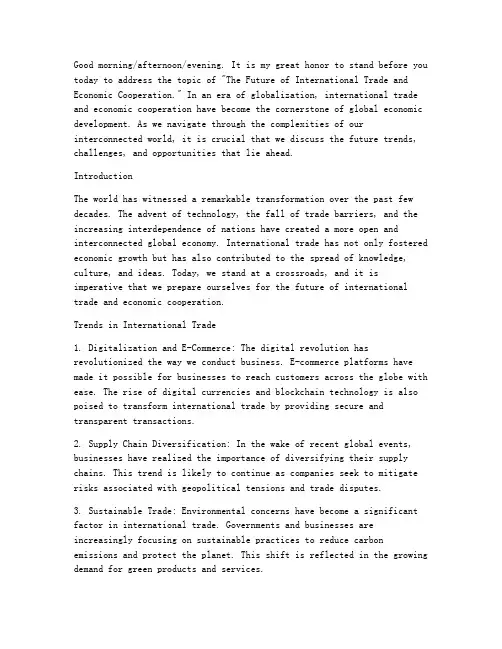
Good morning/afternoon/evening. It is my great honor to stand before you today to address the topic of "The Future of International Trade and Economic Cooperation." In an era of globalization, international trade and economic cooperation have become the cornerstone of global economic development. As we navigate through the complexities of our interconnected world, it is crucial that we discuss the future trends, challenges, and opportunities that lie ahead.IntroductionThe world has witnessed a remarkable transformation over the past few decades. The advent of technology, the fall of trade barriers, and the increasing interdependence of nations have created a more open and interconnected global economy. International trade has not only fostered economic growth but has also contributed to the spread of knowledge, culture, and ideas. Today, we stand at a crossroads, and it is imperative that we prepare ourselves for the future of international trade and economic cooperation.Trends in International Trade1. Digitalization and E-Commerce: The digital revolution has revolutionized the way we conduct business. E-commerce platforms have made it possible for businesses to reach customers across the globe with ease. The rise of digital currencies and blockchain technology is also poised to transform international trade by providing secure and transparent transactions.2. Supply Chain Diversification: In the wake of recent global events, businesses have realized the importance of diversifying their supply chains. This trend is likely to continue as companies seek to mitigate risks associated with geopolitical tensions and trade disputes.3. Sustainable Trade: Environmental concerns have become a significant factor in international trade. Governments and businesses are increasingly focusing on sustainable practices to reduce carbon emissions and protect the planet. This shift is reflected in the growing demand for green products and services.4. Free Trade Agreements: Despite the challenges posed by trade protectionism, free trade agreements continue to play a crucial role in promoting international trade. These agreements help to reduce trade barriers, enhance market access, and foster economic integration.Challenges in International Trade1. Trade Protectionism: The rise of trade protectionism poses a significant challenge to global trade. Tariffs, quotas, and other trade barriers can lead to higher costs for consumers, reduced economic growth, and increased tensions among nations.2. Geopolitical Risks: Geopolitical tensions, such as those betweenmajor economies, can disrupt international trade and economic cooperation. These tensions can lead to trade wars, sanctions, and other forms of economic retaliation.3. Technological Disruption: Rapid technological advancements candisrupt traditional industries and create new challenges forinternational trade. For instance, automation and artificialintelligence may lead to job losses and increased income inequality.4. Environmental Concerns: The environmental impact of international trade is a growing concern. The transportation of goods across borders contributes to greenhouse gas emissions and pollution, necessitating more sustainable practices.Opportunities for Economic Cooperation1. Collaboration on Innovation: Countries can collaborate on researchand development to drive innovation and create new opportunities for international trade. By sharing knowledge and resources, nations can benefit from technological advancements and improve their competitiveness.2. Investment in Infrastructure: Investing in infrastructure, such as ports, roads, and digital networks, can enhance trade efficiency and reduce costs. This investment can also promote economic growth and development in less developed regions.3. Promotion of Sustainable Development: By working together to address environmental challenges, countries can promote sustainable development and ensure the long-term viability of international trade.4. Cultural Exchange: Cultural exchange can foster mutual understanding and cooperation between nations. By promoting tourism, education, and people-to-people exchanges, countries can build stronger relationships and create a more peaceful and prosperous world.ConclusionThe future of international trade and economic cooperation is both promising and challenging. As we navigate through the complexities of our interconnected world, it is crucial that we remain open, adaptable, and collaborative. By embracing the trends, addressing the challenges, and seizing the opportunities, we can build a more prosperous and sustainable future for all.In closing, let us remember that international trade and economic cooperation are not just about economic gains; they are about creating a better world for future generations. Together, we can overcome the obstacles and realize the full potential of international trade and economic cooperation.Thank you for your attention.[Applause]。
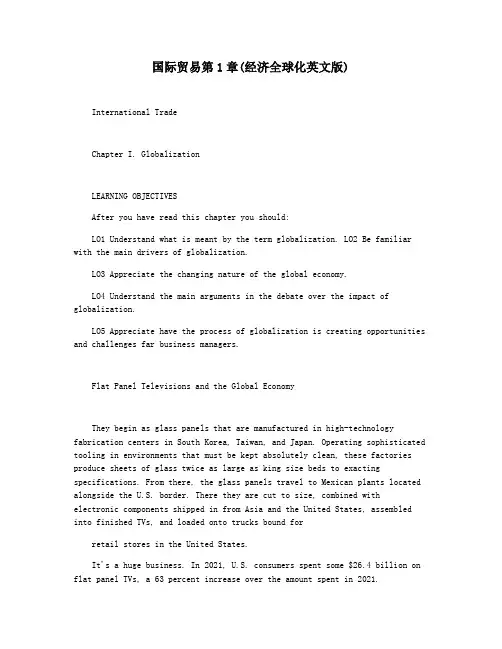
国际贸易第1章(经济全球化英文版)International TradeChapter I. GlobalizationLEARNING OBJECTIVESAfter you have read this chapter you should:LO1 Understand what is meant by the term globalization. LO2 Be familiar with the main drivers of globalization.LO3 Appreciate the changing nature of the global economy.LO4 Understand the main arguments in the debate over the impact of globalization.LO5 Appreciate have the process of globalization is creating opportunities and challenges far business managers.Flat Panel Televisions and the Global EconomyThey begin as glass panels that are manufactured in high-technology fabrication centers in South Korea, Taiwan, and Japan. Operating sophisticated tooling in environments that must be kept absolutely clean, these factories produce sheets of glass twice as large as king size beds to exacting specifications. From there, the glass panels travel to Mexican plants located alongside the U.S. border. There they are cut to size, combined withelectronic components shipped in from Asia and the United States, assembled into finished TVs, and loaded onto trucks bound forretail stores in the United States.It's a huge business. In 2021, U.S. consumers spent some $26.4 billion on flat panel TVs, a 63 percent increase over the amount spent in 2021.Projections call for U.S. sales to hit $37 billion by 2021-despite the fact that due to intense competition, prices for flat panel displays have been tumbling and are projected to continue doing so. During 2021 alone, prices for 40-inch flat panel TVs fell from $3,000 to $1,600, bringing them within the reach of many more consumers. In 200? half of all TVs sold in the United States will be flat panel TVs.The underlying technology for flat panel displays was invented in the United States in the late 1960s by RCA. But after RCA and rivals Westinghouse and Xerox opted not to pursue the technology, the Japanese company Sharp made aggressive investments in flat panel displays. By the early 1990s Sharp was selling the first flat panel screens, but as the Japanese economy plunged into a decade-long recession, investment leadership shifted to South Korean companies such as Samsung. Then the 1997 Asian crisis hit Korea hard, and Taiwanese companies seized leadership. Today, Chinese companies are starting to elbow their way into the flat panel display manufacturing business.As production for flat panel displays migrates its way around theglobe to low-cost locations, clear winners and losers have emerged. One obvious winner has been U. S. consumers, who have benefited from the falling prices of flat panel TVs and are snapping them up Other winners include efficient manufacturers who have taken advantage of globally dispersed supply chains to make and sell low-cost, high-quality flat panel TVs. Foremost among these has been the California-based company, Vizio. Founded by a Taiwanese immigrant, in just four years sales of Vizio flat panel TVs ballooned from nothing to $700 million in 2021. The company is forecasting sales as high as $2 billion for 2021. Vizio, however, has only 75 employees. These employees focus on final product design, sales. and customer service, while Vizio outsources most of its engineering work, all of its manufacturing, and much of its logistics. For each of its models, Vizio assembles a team of supplier partners strung across the globe. Its 42-inch flat panel TV, for example, contains a panel from South Korea, electronic components from China, and processors from the United States, and it is assembled in Mexico. Vizio's managers scour the globe continually for the cheapest manufacturers of flat panel displays and electronic components. They sell most of their TVs to large discount retailers such as Costco and Sam's Club. Good order visibility from retailers, coupled with tight management of global logistics, allows Vizio toturn over its inventory every three weeks, twice as fast as many of its competitors which is a major source of cost saving in a business where prices are falling continually.If Vizio exemplifies the winners in this global industry, the losersinclude the employees of manufacturers who make traditional cathode ray TVs in high-cost locations. In 2021, for example, Japanese electronics manufacturer Sanyo laid off 300 employees at its U.S. factory, and another Japanese company, Hitachi, closed its TV manufacturing plant in South Carolina, laying off 200 employees. Both Sony and Hitachi, of course, still make TVs, but they are flat panel TVs assembled in Mexico from components manufactured in Asia.IntroductionA fundamental shift is occurring, in the world economy. We are moving away from a world in which national economies were relatively self-contained entities, isolated from each other by barriers to cross-border trade and investment; by distance, time zones, and language; ard by national differences in government regulation, culture, and business systems. And we are moving toward a world in which harriers to cross-border trade andinvestment are declining; perceived distance is shrinking, due to advances in transportation and telecommunications technology; material culture isstarting to look similar the world over; and national economies are merginginto an interdependent, integrated global economic system. The process bywhich this is occurring is commonly referred to as globalization.What is happening, in the fiat panel TV Industry, which was profiled inthe Opening Case, is a classic illustration of the impact of globalization. Production of flat panel TVs is migrating around the globe to low-cost locations. TVs that Vizio sells in the United States, for example, ale assembled in Mexico from flat panels manufactured in South Korea, electronic components made in China, and microprocessors made in the United States. By dispersing different activities around the globe to where they can beperformed most efficiently, and then coordinating, the entire production process, companies like Vizio can deliver flat panel TVs to American consumers at much lower prices than would otherwise be possible. American consumers benefit from the lower price, as doe; Vizio and its strategic partners inSouth Korea, China, the United States. and Mexico. The process ofglobalization also has losers, however, and the losers in this case areworkers in high cost locations who have lost their jobs. As we will see in this book感谢您的阅读,祝您生活愉快。
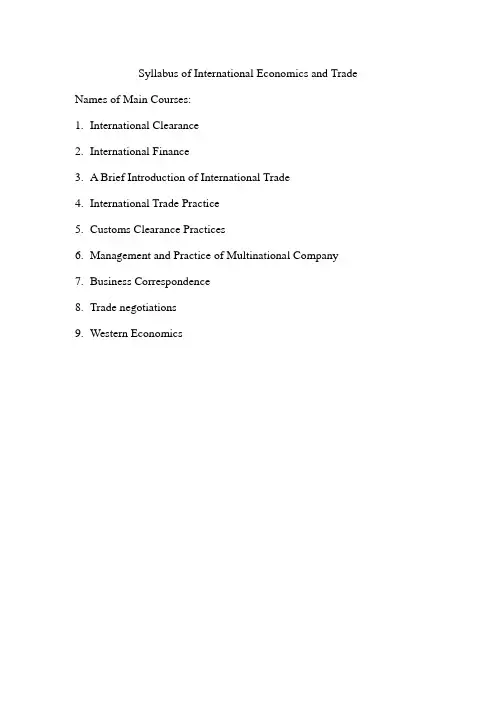
Syllabus of International Economics and Trade Names of Main Courses:1.International Clearance2.International Finance3.A Brief Introduction of International Trade4.International Trade Practice5.Customs Clearance Practices6.Management and Practice of Multinational Company7.Business Correspondence8.Trade negotiations9.Western EconomicsSyllabus of International FinanceFor: International Economics and TradeTotal Class Hours: 54Aims:This course introduces students to International Finance and equips them with basic concepts, and methods to study and analyze international economic issues and problems. It will lay a hard foundation for on Finance study and work in the future.Prerequisites:1.To understand properties, tasks and its researching targets; its system,structure overall2.To grasp basic concepts and theories, basic principles and methods,and development of international finance3.To learn to apply theories and principles to practice and analyzefinancial problems and specific cases with relevant theories.Teaching Mode:Lectures and case studyCourse Contents:Chapter one Foreign Currency and Exchange Rate1.1Definition and categories of currency1.2Definition, exchange quotation and categories of currency Rate1.3Currency basis and main factors affecting it1.4Function of currency changes to economyKey points and Difficulties:Exchange Quotation; main factors and functions of currency and currency changeChapter Two Currency System and Exchange Control2.1 Categories of currency system2.2 Fixed exchange rate and floating exchange rate2.3 History and purpose of exchange control2.4 Measures of exchange control2.5 Functions of exchange control2.6 Evolution and contents of foreign currency management in China2.7 RMB exchange rate system and its theoretical parityKey points and difficulties:Fixed exchange rate system and floating exchange rate system; pegging exchange rate, exchange control, complex exchange rate system, evasion, and arbitrage and Currency convertibilityChapter Three Foreign Exchange Market and Foreign Exchange Transactions3.1W hat is foreign exchange market3.2M ajor international markets and their transaction systems3.3T ransaction means3.3.1Spot transactions and forward transactions3.3.2Arbitrage trading and arbitrage trading3.3.3Swap3.3.4Foreign exchange futures and optionsKey points and difficulties:Foreign exchange market, foreign transaction, spot transaction and forward transaction; arbitrage trading and arbitrage trading, swap, foreign exchange futures and optionsChapter Four Foreign Exchange Risk Management4.1 What is exchange risk4.2 Causes and measures of exchange risk4.3 Enterprise Foreign exchange risk management approaches4.4 Bank Foreign exchange risk management approachKey points and difficulties:Recognize and measure all kinds of risks of foreign exchange and management approachesChapter Five International balance of payments5.1 What is international balance of payments5.2 Economic functions fo balance of payments5.3 Imbalance of international payments and its function5.4 Adjustment methods of imbalance of international paymentsKey points and difficulties:International balance of payments and its preparing methods; causes of imbalance and its functions to economy and adjustment methodsChapter Six International Reserves6.1 What are international reserves6.2 Management principles and policy options of international reserves 6.3 international reserves management in ChinaKey points and difficulties:International reserves, international liquidity, foreign exchange reserves, SDR; management principles and its functions,management principles in ChinaChapter Seven International Financial Markets7.1 What are international financial markets7.2 Classifications of international financial markets7.2.1 Foreign exchange market7.2.2 Money market7.2.3 Capital markets7.3 What are money markets in Europe7.4 Financial derivatives market7.4.1 Financial futures markets and futures trading rules7.4.2 Financial options market and options trading rulesKey points and difficulties:International financial markets, foreign exchange market, money markets, capital markets, money markets in Europe, offshore financial markets, financial derivatives; differences between offshore financial markets and traditional financial markets; financial derivatives trading rules and its supervision.Chapter Eight International Capital Flows8.1 What is international capital flows8.2 Benefits and risks of international capital flows8.3 International debt and its measurement index8.4 Causes and solutions of international debt crisis8.5 International capital flows and financial crisis in developing countries Key points and difficulties:Categories, contents and features of international capital flows; benefits and risks of international capital flowsChapter Nine International Settlement9.1N otes and documents in international settlement9.2M eans of international settlementKey points and difficulties:Categories and definitions of notes and documents in international settlement; different settlement means and usage; general business credit, standby letters of credit and bank guaranteeChapter Ten International Monetary Systems10.1 What are international monetary systems10.2 International monetary system10.2.1 International gold standard10.2.2 Bretton Woods system10.2.3 Jamaica monetary system10.3 Regional monetary system10.3.1 Effect of European Monetary System and European Monetary Union on economy10.4 Functions of European financial institutions in international monetary systemKey points and difficulties:International gold standard, Bretton Woods system, Jamaica monetary system, European Monetary Union, Euro; requirements of developing countries to international monetary system; History of Euro and its functions to world economyChapter Eleven International Finance Theory11.1 International balance of payments theory11.2 Exchange Rate Theory11.3 Theory of international capital flowsKey points and difficulties:Typical views on international balance of payments theory, such as Mercantilism’ theory of the balance of trade, Hume’s Price-cash flow mechanism; Purchasing power parity, psychological exchange, Export of capital, Capital input, Theory of capital controlsClass hour allocation:5 hours per chapter(4 hours for Chapter 11 only), totally 54 hours.Main references:Biaoru, C. (1990). Introduction of International Finance. Shanghai: Huadong Normal University Press.Obstfeld, P. R. K. M. (1998). International Economics. Beijing: Renmin University of China Press.Salvatore, D. (1998). International Economics. Beijing: Qinghua University Press.Shunian, L. (1995). International Finance. Beijing: International Business and Economics University Press.Xiang, T., & Yulu, C. (1996). International Finance and Management.Beijing: Renmin University of China Press.Syllabus of Introduction of International TradeFor: International Economics and TradeTotal Class Hours: 72Aims:This course introduces students to International trade and its theories and policies, and equips them with basic theories, viewpoints and methods to analyze international economic issues and trade problems. It will lay a hard foundation for on Finance study and work in the future.Courses contents:Part One Basis of International TradeChapter One Summary of international tradeAims and requirements:This chapter focuses on the researching objects, means and contents of international trade; students are required to master the basic concepts and the whole frame of international trade system.Key points and difficulties: researching objects, contents and basic conceptsChapter Two International Division of Labor and International Trade Aims and requirements:This chapter mainly touches on the relation between internationaldivision of labor and international trade; students are required to know factors causing labor division and different features of it at different stages; interactive relation between labor division and international trade. Key points and difficulties: main factors affecting international labor division.Chapter Three International Labor Division and World MarketAims and requirements:Students are required to know production and development of world market, systems and main features of world market and makeup and manifestations of price of world market.Key points and difficulties:Current world market systemChapter Four International Trade and Economic GrowthAims and requirements:Students are required to know the growing role of international trade in economy and the interactive relation between international trade and economic growth.Key points and difficulties:Economic growth’s effect to balance of international tradeChapter Five International Trade and Economic StructureAims and requirements:Studens are required to know the interactive relation between international trade and economic structure.Key points and difficulties:Infant industries and their protectionChapter Six Strategic Model of International TradeAims and requirements:Students are required to know the definition of Export and import substitution strategy and the main factors and selection principles affecting Export and import substitution strategyKey points and difficulties:Import substitution strategy and its theoretical basis, Export-oriented strategyPart Two International Trade TheoriesChapter Seven Classical International Trade ModelAims and requirements:Students are required to grasp the main theories of Mercantilism, absolute cost theory, comparative cost theory and Dornbush Fisher Samuelson Model.Key points and difficulties:Ricardo - Krugman modelChapter Eight Neoclassical International Trade ModelAims and requirements:Students are required to know Equilibrium open economy, mutual needs theory, factor endowment theory and Leontief MysteryKey points and difficulties:Mutual needs theory and factor endowment theoryChapter Nine Imperfect Competition Model of International TradeAims and requirements:Students are required to master scale economy and international trade, intraindustrial international trade, imperfect competitive market and International Competitive AdvantageKey points and difficulties:Intraindustrial international tradeChapter Ten Dynamic International Trade ModelAims and requirements:Students are required to master product life cycle theory, technological gap theory, technology spillover and “scientific” model and neoclassicaltheory.Key points and difficulties:Product life cycle theory and technological gap theoryChapter Eleven New Elements Model of International TradeAims and requirements:Students are required to know human capital and international trade; R&D and international trade, information and international trade, systems and international trade.Key points and requirements:Human capital and international tradeChapter Twelve Model of International Factor MobilityAims and requirements:Students are required to master international capital flow model, international factor and goods mobility and international technology mobility model.Key points and difficulties:International capital flow modelPart Three International Trade PolicyChapter Thirteen Introduction of International Trade PolicyAims and requirements:Students are required to know the evolution of international trade, options of international trade policy and its features, to lay a basis for future study.Chapter Fourteen Tariff MeasuresAims and requirements:Students are required to grasp rate of tariff protection and tariff effects models and know of tariff, tariff system and types of tariffKey points and difficulties:Tariff effects modelChapter Fifteen Non-tariff MeasuresAims and requirements:Students are required to grasp analysis of non-tariff effects and know types of non-tariff measures and its basic featuresKey points and difficulties:Analysis of non-tariff measure effectsChapter Sixteen Export Promotion and Export ControlAims and requirements:Students are required to grasp measures of export promotion and knowhow to analyze the economic effects export promotion and export control. Key points and difficulties:Measures of export promotionChapter Seventeen Strategic Trade PolicyAims and requirements:Students are required to know the theoretical basis of strategic trade policy, basic model and its applicationKey points and difficulties:Theoretical basis of strategic trade policyChapter Eighteen Political Economy of Trade PolicyAims and requirements:Students are required to know trade policy and political factors, rent-seeking and trade policy; game and coordination in international trade policy.Key points and difficulties:Trade policy and political factorPart Four International Trade TopicsChapter Nineteen World Trade Organization and International Trade Aims and requirements:Students are required to grasp the principles and main functions of WTO; know features of GATT related with WTO, analyze the relation among WTO, world trade and China.Key points and difficulties:Principles and functions of WTOChapter Twenty Regional Economic Integration and International Trade Aims and requirements:Students are required to know main content and forms, interactive relation and models of regional economic integrationKey points and difficulties:Models of regional economic integrationChapter Twenty One International Investment and TradeAims and requirements:Students are required to learn the main content and forms, interactive relation and theories of international investmentKey points and difficulties:International investment theoryChapter Twenty Two Transnational Corporation and International Trade Aims and requirements:Students are required to know general features of transnational corporation, major features of management and its effect on macro economyKey points and difficulties:Management of transnational corporationChapter Twenty Three International Trade in ServiceAims and requirements:Students are required to general features of transnational corporation, major features of management and its effect on macro economyKey points and difficulties:Models of international trade in serviceChapter Twenty Four International Trade PatternsAims and requirements:Students are required to know trade features of developed countries and developing countries; to know international economic order and trade patterns and their adjustments.Key points and difficulties:International economic order and trade patterns, and their adjustments.\Main referenceSalvatore, D. (1998). International Economics. Beijing: QingHua University Press.Xian, C. (1998). International Trade Shanghai Lixin Accounting Publishing HouseXinlei, S. (2001). Theories and Policies of International Economics.Chengdu: Southwestern University of Finance and Economics Press.Syllabus of International Trade PracticeFor: International economics and tradeTotal class hours: 36International Trade Practice is a backbone course of specialty of Trade Economics,and it is a course of studying the procedure of international exchange of commodities, and it also have characteristics of foreign activities. The task of this course is: In terms of practice and law, analyzing and studying various kinds of methods of international exchange of commodities, summarizing foreign practical experiences in order to carry out the principles and policies of foreign trade of our country, not only can guarantee the best economic benefits, but also can handle affairs according to the international practice, and make our basic methods can be generally accepted for the international community. Through this course students are required to master basic theories, knowledge and basic skill of the foreign trade business, understand the trade procedure of imports and exports and grasp the method and skill of drafting sales contract clauses.Part One International Trade TermsChapter One International Trade TermsAims:Trade term is the key content of this course. It requires students tograsp the explanations for 13 trade terms of INCO terms 2000 through studying, especially the definitions, characteristic and applications of some important trade term.Key points:The coverage of INCO terms 2000; the meaning of FOB, CFR, CIF, FCA ,CPT, CIP, shipment contract, Symbol Delivery, the varieties of trade term.Teaching difficulties:The same points and different points of FOB, CFR, CIF and the difference among FCA, CPT, CIP, summary of trade terms, choosing of trade terms.Teaching contentLaws and practices for sales of international cargo, the main content of sales contracts, general procedure of sale-goods and main content of this course.Part Two International Sale of GoodsChapter Two Name, Quality and PackingAims:This chapter requires students to study and grasp the importance concluding the quality clause and basic method in the sales contract through this Section, and grasp how to stipulate quantity clauses, andstudy the basic content of the packaging clause, and grasp the general description about the goods on the whole.Key points:Choosing the methods of descript quality correctly, using chipping mark, more and short clause and neutral packing.Teaching Difficulties:Related stipulations about quantity clause of ConversionChapter Three Transport of International GoodsAims:This Section is emphasis the modes of transport,how to stipulate the shipment clause in the contract,how to deal with the shipment document, especially the ocean transportation.Key points:Mode of ocean transport, related documents, clause, accounting the freight of line transportTeaching difficulties:Nature of B/L, kinds of B/L, stipulations about partial shipment and transshipment in UCP500Chapter Four Insurance of International GoodsAims:This Section tells mainly that transports the range that the cargo insurance gives cover for by sea, our country transports cargo insurance risk and such contents as the clause and transportation insurance practice of cargoes imported and exported, etc. by sea.Key points:Related knowledge about insurance of ocean transportTeaching difficulties:Decision of insurance amount, Choice of insurance averageChapter Five Price of International GoodsAims:Through the studying of this chapter, student can grasp the price of the imported and exported goods correctly, adopting various kinds of and fix a price for the method rationally, selecting the favorable pricing currency for use, using relevant commission and discount properly, and ordering the price clause in the contract.Key points:Accounting the commission and discount, exchange the price. Teaching difficulties:Choice to the method of accounting the priceChapter Six Collection and PaymentAims:This chapter mainly introduces the process of international settlement, such as means of payment, payment time, payment place, etc. Among them the L/C and its related issues are discussed in great details. This Section is a key Section of this book.Key points:Draft, L/C, International Factor and Choice of payment instruments. Teaching difficulties:Transferable L/C, relationship of 3 periods of L/C, Usance L/ C payable at sight.Chapter Seven Inspection, Claim, Arbitration and Force Majeure Aims:This chapter mainly introduces inspection, claim, arbitration, Force Majeure and related knowledge in international merchandise trade.Key points:Choosing the time and the place of inspection, deciding the claim party, stipulating the claim clause, judgment of Force Majeure matter, forms and functions of arbitration, results of arbitrationTeaching difficulties:Commencement and termination of Force MajeurePart Three Trade Negotiation and Contract PreparationChapter Eight Export Business Negotiation and Conclusion of ContractAims:This Section tells the general procedures of business negotiation, the basically contents and establishment of contract, etc.Key points:This Section is key on offer and accept, effective time, whether to revocable or withdraw.Teaching difficulties:Stipulations about offer and accept in ConventionChapter Nine Performance of Import and Export ContrastAims:This chapter mainly talks about the main steps in the general process in performance of the contract and its related issues that should be pay close attention to.Key points:The key points of Urging establishment of L/C, notices of verify the L/C Teaching difficulties:Auditing of credit amount and Export bill purchasePart Four International Trade FormsChapter Ten International Trade FormsAims:This chapter mainly tells about the concept and characteristic of various trade forms; main contents of various trade agreement; and issues of using various trade forms.Key points:Distribution, Sole Distribution, Solo Agent or Exclusive Agent, Consignment, Fairs and Sales, Invitation to Tender and Submission, Auction, Processing tradeTeaching difficulties:The Comparison of Sole Distribution and Solo Agent, differences of processing with imported material and supplied material.Main reference:Baifu, W. (1996). Textbook of Import and Export Trade Practice.Shanghai: Shanghai People's Press.Xiaoxian, L. (1994). International Trade Practice. Beijing University Press of International Business and Economics.Yongyou, Y. (1999). International Trade Practice. Wuhan: Hubei People's Press.。

第2 章现代贸易理论的基础现代贸易理论试图回答如问题:(1) 贸易基础(basis for trade) 由什么构成--即国与国之间为什么要进和出口某些商品? (2) 商品在世界市场按什么样的贸易条件(terms of trade)( 相对价格)进行交换?(3) 从生产和消费方面来看,国际贸易收益(gains from internationa1 trade) 是什么?本章将首先毓要回顾现代贸易理论的发展历史,然后介绍分析国际贸易影响时用到的理论工具,进而探讨这些问题。
现代贸易理论的发展历史现代贸易理论是经济思想进化的产物。
重商主义以及后来的亚当•斯密和人卫•李嘉图的著作都为现代贸易理论提供了框架。
重商主义在1500-1800年间,欧洲出现了一批关注国家建设的学者。
按照重商主义(merc antists)的观点,一个吲家如何管理它的国内和国际事务以提高自身的利益,是建设国家的中心问题,而拥有一个强大的对外贸易部门则是该问题的答案。
如果一个国家能够实现贸易顺差(出口超过进口的剩余),就可以得到世界其他国家支付的黄金和白银。
这种收入将增加消费,提高国内的产出和就业水平。
为了促成贸易顺差,重商主义学派主张政府进行贸易管制,并建议采用关税、配额和其他商业政策将进口限制在最低水平,以保护一个国家的贸易地位。
进入18世纪,重商主义的经济政策受到了强烈的攻击。
根据大卫•休谟的价格流转学说doctrine),贸易顺差只可能是短期的,会随着时间的推移自动消除。
为说明这一点,假定余,导致黄金和白银流入。
由于这些贵金属构成了英国货币供给的一部分,它们的流入会增加流通中的货币数量,从而使得英国的物价水平相对于其贸易伙伴的而言比较高。
物价水平的上升会激励英国居民购买外国生产的商品,同时英国的出口额会降低。
结果是,该国的贸易盈余最终将自动消除。
休谟的价格流转机制表明,重商主义的政策最多只能带来短期的经济优势。
重商主义学派从静态的视角分析世界经济,这也是他们遭到攻击的一个原因。
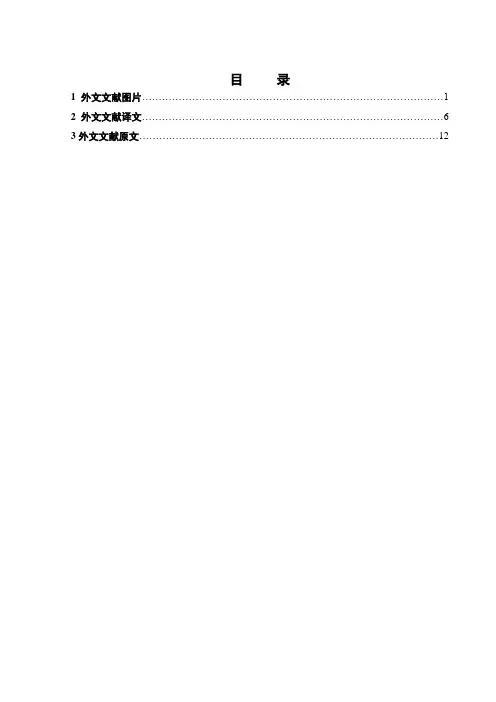
目录1 外文文献图片 (1)2 外文文献译文 (6)3外文文献原文 (12)外文文献译文总结:在最近的这几年来,贸易自由化对于国内的影响一直受到严密的监控。
贸易自由化和全球化的其它方面被指责成造成美国的收入不均和欧洲的失业率的根本原因。
问题的关键还在于低工资发展中国家的贸易。
虽然经济学家一直都在研究这个问题,但是却并没有找到明确的答案。
本文探讨了这种模棱两可的问题的一些原因。
内生性和同时性虽然可以产生主要的问题,但这引起业内人士指责,还是应该应该适当地归因于其他因素的发展。
但是即使仅仅针对贸易自身,它也有不能确定的影响。
这只是在最简单的赫克歇尔-俄林理论下,批评者对贸易自由化可以预测的明确结果。
1介绍在最近几年来,贸易和经济开放一直在增长,于是各个利益集团的获利影响一直被争论。
低技能工人的工资和薪水在因为全球化可能引起的潜在后果,受到特别的关注。
由于工业化国家与发展中低薪水国家的贸易份额得到增加,导致这场争论已经愈演愈烈。
在美国以及欧洲,人们对于工作,工资和生活标准时刻处于风险当中而感到恐惧的情况普遍存在,尤其是在和那些从底薪国家来的工人直接与直接竞争的地区尤为严重。
在经济学家中,争论集中在美国收入显著不平等的兴起和欧洲的失业率持续增加引起的贸易和技术变革的相对贡献。
贸易经济学家们倾向于应该减少在这些发达国家的交易规则,而大量的劳动经济学家则抱持着相反的意见。
尽管这场争论远远没有解决争端,但是它在理论和实证两个方面揭示了极其复杂的问题。
第二节列出了基本问题以及在所有商品自由流通的基础上交易的两个产品-三个要素模型对工资和就业影响的后果。
第三节部分认为最终产品就是非流通股,但它的一些部件和组件可以流通,从而可以从境外进行采购。
境外采购可能涉及海上生产和对外直接投资。
第四节探讨了资本流动的影响。
第五部分在讲述潜在的失业问题。
第六节提供了一些结论性的意见。
2海外采购和相对工资传统贸易理论的奠基石之一是在因素比例在测定专业化和贸易时的作用。
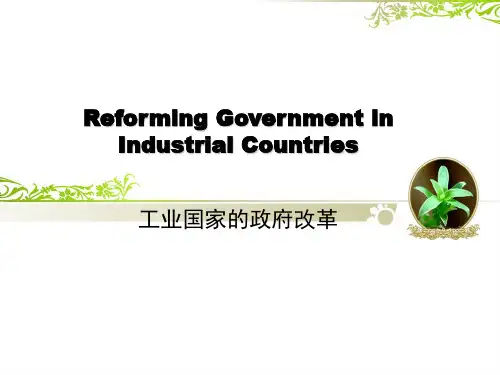
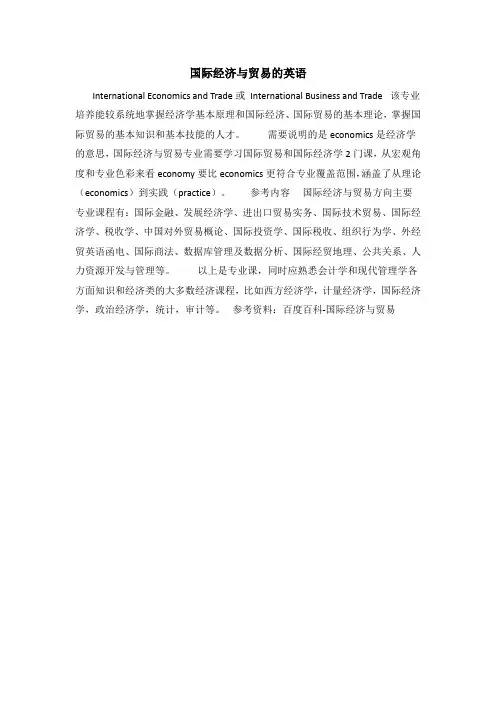
国际经济与贸易的英语
International Economics and Trade或International Business and Trade 该专业培养能较系统地掌握经济学基本原理和国际经济、国际贸易的基本理论,掌握国际贸易的基本知识和基本技能的人才。
需要说明的是economics是经济学的意思,国际经济与贸易专业需要学习国际贸易和国际经济学2门课,从宏观角度和专业色彩来看economy要比economics更符合专业覆盖范围,涵盖了从理论(economics)到实践(practice)。
参考内容国际经济与贸易方向主要专业课程有:国际金融、发展经济学、进出口贸易实务、国际技术贸易、国际经济学、税收学、中国对外贸易概论、国际投资学、国际税收、组织行为学、外经贸英语函电、国际商法、数据库管理及数据分析、国际经贸地理、公共关系、人力资源开发与管理等。
以上是专业课,同时应熟悉会计学和现代管理学各方面知识和经济类的大多数经济课程,比如西方经济学,计量经济学,国际经济学,政治经济学,统计,审计等。
参考资料:百度百科-国际经济与贸易。
国际经济与贸易全英文专业International Economics and Trade is a major that focuses on the study of international economic relations and international trade. It aims to cultivate students' understanding and ability to analyze the economic and trade activities of countries around the world, as well as the impact of these activities on global economic development.The courses offered in this major usually include international economics, international trade theory, international finance, international marketing, and international business law. Through these courses, students can learn about the basic theories and practices of international economic and trade activities, and understand the rules and policies of the international market.In addition, students in this major will also learn about the cultures, business practices, and economic systems of different countries and regions, which helps them better adapt to the international business environment and conduct effective communication and cooperation with people from different backgrounds.Graduates of this major can engage in international trade, international business, international finance, and other related fields. They can work in multinational corporations, foreign trade companies, import and export agencies, government agencies, and international organizations. Their roles may include international trade specialist, international business analyst, international marketing manager, and customs declarer.Overall, the International Economics and Trade major provides students with comprehensive knowledge and skills in international economic and trade, helping them become professionals who can adapt to the global business environment and engage in international trade and business activities.。
国际经济与贸易学科基础课International Economics and Trade: A Fundamental Discipline国际经济与贸易(International Economics and Trade)是一个重要的学科基础课,涵盖了国际经济关系、国际贸易、外汇交易、国际金融等领域。
这门课程的学习旨在培养学生的贸易意识、经济分析能力以及国际竞争力。
在全球化的今天,国际经济与贸易的重要性日益凸显。
全球各国之间的贸易往来和经济联系日益紧密,而国际经济与贸易正是研究这种联系和贸易关系的学科。
通过学习这门课程,学生可以深入了解不同国家之间的贸易政策、贸易壁垒以及国际经济发展的趋势。
学习国际经济与贸易还可以帮助学生了解全球市场的运作机制。
由于全球贸易和投资的自由化,国际市场竞争激烈,了解市场的运作规律对于企业和个人来说至关重要。
学习这门课程,学生可以学习到国际贸易政策、国际支付方式、跨国公司运作模式等内容,为未来的职业生涯打下坚实的基础。
此外,国际经济与贸易对于国家之间的经济合作和发展也起着重要作用。
学生通过学习贸易理论和实务,可以了解到国际贸易对于国家的经济发展和就业创造的重大影响。
他们也可以学习到国家间合作的机制和方法,为未来参与国际合作和谈判提供理论支持。
国际经济与贸易的基础课还有助于培养学生的经济思维和分析能力。
学生通过学习经济学原理和相关的贸易理论,可以培养自己的分析和解决实际问题的能力。
此外,学生还可以学习到国际经济指标的分析方法和金融市场的运作规律,从而更好地应对经济变化和市场风险。
因此,国际经济与贸易是一门重要的学科基础课,不仅可以为学生的职业发展提供必要的知识和技能,还可以培养学生的全球意识和经济思维。
无论是进入国际贸易领域,还是从事相关领域的工作,国际经济与贸易的学习都将为学生的未来发展奠定坚实的基础。
国际经济与贸易专业(全英文授课)Syllabus of Calculus for Business and Economics Course Code: MATH1001Total Teaching Hours:64Total Credits: 4Pre-required Courses: Basic knowledge of MathematicsCourse DescriptionThis course is a required mathematical course for the Business-studying students. Calculus is the fundamental of the following course, such as statistics. In this course, students will learn to use the advanced mathematical knowledge to solve the applied problems in Business and Economics. Also the purpose of this course is to prepare the students for the following special course.Required Texts & MaterialsRaymond A.Barnett,Micheal R. Ziegler, Karl E. Byleen. Calculus for Business, Economics, Life Science, and Social Science(Ninth Edition),Higher Education Press,2005GradingHomework Assignments and Class Participation, etc. 30%Final Exam 70%The grades will be assigned as follows:90-100 A80-89 B70-79 C60-69 D0-59 FAssessmentsHomework Assignments - There will be homework assignments every weeks. You may discuss homework questions with your classmates; however, it has to be your individual work. You have to submit your solution file for each assignment immediately after you are notified. The due date for each assignment will be announced when the homework are assigned. Late submission will cause penalty on the grade.Final Exam - The written final exam will be given at end of the semester. The exam duration is 2 hours. The final exams will focus on the text, lectures and homework assignments. It will consist of 7 multiple-choice questions, 7 short answers, 4 calculation problems and 3 application questions. A sample of the final exam will be posted for your reference before the exam.Class AttendanceSchool policy dictates that attendance is mandatory. You should come to every class on time, stay for the entire class, and be attentive during the class unless you have a family or health related emergency. If you do miss a class it is your responsibility to get lecture notes and assignments from another student. If you miss more than three classes the Instructor reserves the right to drop you from the course.Class PreparationAs a guideline, you should expect to spend at least 3 hours per week preparing for class. I will let you know what we will study next week. Do not get behind. You need to spend significant time on class preparation before every class rather than letting work pile up.。
外文资料翻译FOREIGN LITERATURE TRANSLATION专业:国际经济与贸易姓名:林文津指导教师姓名:田桂玲外国直接投资的流入是否会排挤韩国国内投资?关键词:投资,经济增长,韩国摘要:本文提供了一些有关韩国国内从1985至1999年间外国直接投资和经济增长,以及韩国国内投资之间的关系的证据和经验。
通过采用向量自回归模型和创新型的会计方法,探索外国直接投资,本地直接投资和出口之间的动态关系。
我们发现外国直接投资对经济增长有着积极的作用,但是这种作用却不是很明显。
从另一方面来说,经济增长对外国直接投资水平有着显著和持久的影响。
同时由于外国直接投资外生性的影响,我们发现外国投资表现出了对国内宏观经济条件强劲的内生性,这在之前的工作研究中是尚未被发现的。
我们并不认为韩国国内的外国直接投资会排挤国内投资。
一、引言从20世纪80年代中期开始,随着跨国公司的发展,世界范围内的国外直接投资流动的快速增长就如同驱动国际经济活动增长的引擎一般。
无论是工业化国家还是发展中国家都十分乐于接受国外直接投资流动,这样,这些国家对于外国直接投资政策的改变大多是在外国直接投资流动的自由化方面。
虽然外国直接投资的流量和存量大多集中在工业化国家和发展中国家,特别是亚太领域内,近年来这个地区对外国直接投资的吸收呈现增长趋势。
因此,近年来外国直接投资成为了发展中国家外来资本的主要来源,尤其是在亚洲。
因此,近年来关于外国直接投资对经济增长作用的实证研究课题越来越多。
虽然对外直接投资越来越被人们重视,但外来直接投资对经济增长的重要作用也被视为是理所当然的,特别是在新的内生性增长理论方面。
实证研究的传统方法是通过利用外商直接投资回归输出流量的增长来构建数据框架,以及考察其他对经济增长有影响的因素。
但是这些相关经验所表现出来对经济增长方式的主要问题是估计值被解释为意味着一些实际的因果关系,但忽略了反馈的因素,因此高度限制了动态化。
国际贸易与经济系课程介绍(中英对照)序号:1课程编码:15001030课程名称:微观经济学Microeconomics学分:3周学时:3开课系部:国际贸易与经济系预修课程:微积分修读对象:本科生课程简介:微观经济学着重研究作为消费者和生产者的单个经济主体如何在市场机制的运行中做出经济决策。
本课程同时对作为市场监管者的政府行为进行研究。
主要内容涉及消费者行为理论、市场体制、需求弹性和供给弹性、生产者行为理论、完全竞争、垄断、垄断性竞争和寡头垄断、市场失灵和微观经济政策等。
拟用教材:《微观经济学》,高鸿业编著,中国人民大学出版社,2001年8月出版参考教材:《西方经济学》,许纯祯主编,高等教育出版社,2000年出版;《Microeconomics》,Andrew Schotter,高等教育出版社,2001年出版Course Code:15001030Course Title: MicroeconomicsCredit: 3Weekly study period: 3Department: International Trade and Economics DepartmentPreparatory Course: CalculusStudents: undergraduatesContent: Microeconomics is the study of one’s economic behavior who as consumer and producer.It explains which factors influence individual economic choices of various decision-makersoperating as individual consumers and producers are coordinated by impersonal markerforces. Microeconomics also involves the study of the role of government as marketregulator and provider of goods and services across the economy. The main contentsinclude consumer choice and demand, the market system, elasticity of demand and supply,producer’s behavior, perfect competition, monopoly, monopolistic competition andoligopoly, market failure, microeconomic policies and so on.Course Book: Microeconomics Gao Hongye, Renmin University of China Press.Reference Book:《Microeconomics》, Xn chunzhen,Ed.2000, High education Press; 《Microeconomics》,Andrew Schotter,Ed.2000, High education Press序号:2课程编码:15002030课程名称:微观经济学(双语)Microeconomics (Bilingual)学分:3周学时:3开课系部:国际贸易与经济系预修课程:微积分修读对象:本科生(经济学专业)课程简介:本课程主要向学生介绍微观经济学的一些核心概念,介绍进行经济学分析所需要的各种基本方法和工具,讲解消费者行为理论、厂商理论、成本理论、市场结构理论等微观经济学的基本原理,并结合实际经济问题让学生了解微观经济政策的应用等等。
Syllabus of International Economics and Trade Course Title:1. International Clearance2. International Finance3. A Brief Introduction of International Trade4. International Trade Practice5. Customs Clearance Practices6. Management and Practice of Multinational Company7. Business Correspondence8. Trade negotiations9. Western EconomicsSyllabus of International FinanceFor: International Economics and Trade Total Class Hours: 54 Aims:This course introduces students to International Finance and equips them with basic concepts, and methods to study and analyze international economic issues and problems. It will lay a hard foundation for on Finance study and work in the future.Prerequisites:1. To understand properties, tasks and its researching targets; its system, structure overall2. To grasp basic concepts and theories, basic principles and methods, and development of international finance3. To learn to apply theories and principles to practice and analyze financial problems and specific cases with relevant theories.Teaching Mode:Lectures and case studyCourse Contents:Chapter one Foreign Currency and Exchange Rate1.1Definition and categories of currency1.2Definition, exchange quotationand categories of currency Rate1.3Currency basis and main factors affecting it1.4Function of currency changes to economyKey points and Difficulties:Exchange Quotation; main factors and functions of currency and currency change Chapter Two Currency System and Exchange Control2.1 Categories of currency system2.2 Fixed exchange rate and floating exchange rate2.3 History and purpose of exchange control2.4 Measures of exchange control2.5 Functions of exchange control2.6 Evolution and contents of foreign currency management in China2.7 RMB exchange rate system and its theoretical parityKey points and difficulties:Fixed exchange rate system and floating exchange rate system; pegging exchange rate, exchange control, complex exchange rate system, evasion, and arbitrage and Currency convertibilityChapter Three Foreign Exchange Market and Foreign Exchange Transactions3.1 What is foreign exchange market3.2 Major international markets and their transaction systems3.3 Transaction means3.3.1 Spot transactions and forward transactions3.3.2 Arbitrage trading and arbitrage trading3.3.3 Swap3.3.4 Foreign exchange futures and optionsKey points and difficulties:Foreign exchange market, foreign transaction, spot transaction and forward transaction; arbitrage trading and arbitrage trading, swap, foreign exchange futures and optionsChapter Four Foreign Exchange Risk Management4.1 What is exchange risk4.2 Causes and measures of exchange risk4.3 Enterprise Foreign exchange risk management approaches4.4 Bank Foreign exchange risk management approachKey points and difficulties:Recognize and measure all kinds of risks of foreign exchange and management approachesChapter Five International balance of payments5.1 What is international balance of payments5.2 Economic functions fo balance of payments5.3 Imbalance of international payments and its function5.4 Adjustment methods of imbalance of international paymentsKey points and difficulties:International balance of payments and its preparing methods; causes of imbalance and its functions to economy and adjustment methodsChapter Six International Reserves6.1 What are international reserves6.2 Management principles and policy options of international reserves6.3 international reserves management in ChinaKey points and difficulties:International reserves, international liquidity, foreign exchange reserves, SDR; management principles and its functions,management principles in ChinaChapter Seven International Financial Markets7.1 What are international financial markets7.2 Classifications of international financial markets7.2.1 Foreign exchangemarket7.2.2 Money market7.2.3 Capital markets7.3 What is money markets in Europe7.4 Financial derivatives market7.4.1 Financial futures markets and futures trading rules7.4.2 Financial options market and options trading rulesKey points and difficulties:International financial markets, foreign exchange market, money markets, capital markets, money markets in Europe, offshore financial markets, financial derivatives; differences between offshore financial markets and traditional financial markets; financial derivatives trading rules and its supervision.Chapter Eight International Capital Flows8.1 What is international capital flows8.2 Benefits and risks of international capital flows8.3 International debt and its measurement index8.4 Causes and solutions of international debt crisis8.5 International capital flows and financial crisis in developing countriesKey points and difficulties:Categories, contents and features of international capital flows; benefits and risks of international capital flowsChapter Nine International Settlement9.1 Notes and documents in international settlement9.2 Means of international settlementKey points and difficulties:Categories and definitions of notes and documents in international settlement; different settlement means and usage; general business credit, standby letters of credit and bank guaranteeChapter Ten International Monetary Systems10.1 What are international monetary systems10.2 International monetary system10.2.1 International gold standard10.2.2 Bretton Woods system10.2.3 Jamaica monetary system10.3 Regional monetary system10.3.1 Effect of European Monetary System and European Monetary Union on economy10.4 Functions of European financial institutions in international monetary system Key points and difficulties:International gold standard, Bretton Woods system, Jamaica monetary system, European Monetary Union, Euro; requirements of developing countries to international monetary system; History of Euro and its functions to world economyChapter Eleven International Finance Theory11.1 International balance of payments theory11.2 Exchange Rate Theory11.3 Theory of international capital flowsKey points and difficulties:Typical views on international balance of pay ments theory, such as Mercantilism ’ theory of the balance of trade, Hume’ s Price-cash flow mechanism; Purchasing power parity, psychological exchange, Export of capital, Capital input, Theory of capital controlsClass hour allocation:5 hours per chapter(4 hours for Chapter 11 only, totally 54 hours.Main references:Biaoru, C. (1990. Introduction of International Finance. Shanghai: HuadongNormal University Press. Obstfeld, P. R. K. M. (1998. International Economics. Beijing: Renmin University of China Press. Salvatore, D. (1998. International Economics. Beijing: Qinghua University Press. Shunian, L. (1995. International Finance. Beijing: International Business and Economics University Press. Xiang, T., & Yulu, C. (1996.International Finance and Management. Beijing: Renmin University of China Press. Topics include: the foreign exchange market, balance of payments, international investment and banking, monetary and fiscal policy in an open economy, economic integration and monetary unification, the internati onal monetary system, and optimum currency areas. Each student is required to write a short paper on a current problem in international finance.。
Syllabus of International Economics and Trade Course Title:1.International Clearance2.International Finance3.A Brief Introduction of International Trade4.International Trade Practice5.Customs Clearance Practices6.Management and Practice of Multinational Company7.Business Correspondence8.Trade negotiations9.Western EconomicsSyllabus of International FinanceFor: International Economics and Trade Total Class Hours: 54 Aims:This course introduces students to International Finance and equips them with basic concepts, and methods to study and analyze international economic issues and problems. It will lay a hard foundation for on Finance study and work in the future.Prerequisites:1.To understand properties, tasks and its researching targets; its system,structure overall2.To grasp basic concepts and theories, basic principles and methods,and development of international finance3.To learn to apply theories and principles to practice and analyzefinancial problems and specific cases with relevant theories.Teaching Mode:Lectures and case studyCourse Contents:Chapter one Foreign Currency and Exchange Rate1.1Definition and categories of currency1.2Definition, exchange quotation and categories of currency Rate1.3Currency basis and main factors affecting it1.4Function of currency changes to economyKey points and Difficulties:Exchange Quotation; main factors and functions of currency and currency changeChapter Two Currency System and Exchange Control2.1 Categories of currency system2.2 Fixed exchange rate and floating exchange rate2.3 History and purpose of exchange control2.4 Measures of exchange control2.5 Functions of exchange control2.6 Evolution and contents of foreign currency management in China2.7 RMB exchange rate system and its theoretical parityKey points and difficulties:Fixed exchange rate system and floating exchange rate system; pegging exchange rate, exchange control, complex exchange rate system, evasion, and arbitrage and Currency convertibilityChapter Three Foreign Exchange Market and Foreign Exchange Transactions3.1 What is foreign exchange market3.2 Major international markets and their transaction systems3.3 Transaction means3.3.1 Spot transactions and forward transactions3.3.2 Arbitrage trading and arbitrage trading3.3.3 Swap3.3.4 Foreign exchange futures and optionsKey points and difficulties:Foreign exchange market, foreign transaction, spot transaction and forward transaction; arbitrage trading and arbitrage trading,swap, foreign exchange futures and optionsChapter Four Foreign Exchange Risk Management4.1 What is exchange risk4.2 Causes and measures of exchange risk4.3 Enterprise Foreign exchange risk management approaches4.4 Bank Foreign exchange risk management approachKey points and difficulties:Recognize and measure all kinds of risks of foreign exchange and management approachesChapter Five International balance of payments5.1 What is international balance of payments5.2 Economic functions fo balance of payments5.3 Imbalance of international payments and its function5.4 Adjustment methods of imbalance of international paymentsKey points and difficulties:International balance of payments and its preparing methods; causes of imbalance and its functions to economy and adjustment methodsChapter Six International Reserves6.1 What are international reserves6.2 Management principles and policy options of international reserves6.3 international reserves management in ChinaKey points and difficulties:International reserves, international liquidity, foreign exchange reserves, SDR; management principles and its functions,management principles in ChinaChapter Seven International Financial Markets7.1 What are international financial markets7.2 Classifications of international financial markets7.2.1 Foreign exchange market7.2.2 Money market7.2.3 Capital markets7.3 What is money markets in Europe7.4 Financial derivatives market7.4.1 Financial futures markets and futures trading rules7.4.2 Financial options market and options trading rulesKey points and difficulties:International financial markets, foreign exchange market, money markets, capital markets, money markets in Europe, offshore financial markets, financial derivatives; differences between offshore financial markets and traditional financial markets; financial derivatives trading rules and its supervision.Chapter Eight International Capital Flows8.1 What is international capital flows8.2 Benefits and risks of international capital flows8.3 International debt and its measurement index8.4 Causes and solutions of international debt crisis8.5 International capital flows and financial crisis in developing countriesKey points and difficulties:Categories, contents and features of international capital flows; benefits and risks of international capital flowsChapter Nine International Settlement9.1 Notes and documents in international settlement9.2 Means of international settlementKey points and difficulties:Categories and definitions of notes and documents in international settlement; different settlement means and usage; general business credit, standby letters of credit and bank guaranteeChapter T en International Monetary Systems10.1 What are international monetary systems10.2 International monetary system10.2.1 International gold standard10.2.2 Bretton Woods system10.2.3 Jamaica monetary system10.3 Regional monetary system10.3.1 Effect of European Monetary System and European Monetary Union on economy10.4 Functions of European financial institutions in international monetary system Key points and difficulties:International gold standard, Bretton Woods system, Jamaica monetary system, European Monetary Union, Euro; requirements of developing countries to international monetary system; History of Euro and its functions to world economyChapter Eleven International Finance Theory11.1 International balance of payments theory11.2 Exchange Rate Theory11.3 Theory of international capital flowsKey points and difficulties:Typical views on international balance of payments theory, such as Mercantilism’theory of the balance of trade, Hume’s Price-cash flow mechanism; Purchasing power parity, psychological exchange, Export of capital, Capital input, Theory of capital controlsClass hour allocation:5 hours per chapter(4 hours for Chapter 11 only), totally 54 hours.Main references:Biaoru, C. (1990). Introduction of International Finance. Shanghai: HuadongNormal University Press.Obstfeld, P. R. K. M. (1998). International Economics. Beijing: Renmin University of China Press.Salvatore, D. (1998). International Economics. Beijing: Qinghua University Press.Shunian, L. (1995). International Finance. Beijing: International Business and Economics University Press.Xiang, T., & Yulu, C. (1996). International Finance and Management. Beijing: Renmin University of China Press.Topics include: the foreign exchange market, balance of payments, international investment and banking, monetary and fiscal policy in an open economy, economic integration and monetary unification, the international monetary system, and optimum currency areas. Each student is required to write a short paper on a current problem in international finance.。